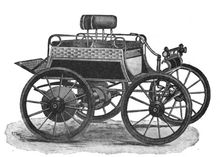Dos-à-dos

A dos-à-dos (pronounced: "do-sa-do" ) is a carriage with bench seats arranged back to back. This seating arrangement was found on carriages and early automobiles . The term comes from French and literally means "back to back".
Advantage over the offered at the same time Vis-à-vis arrangement the position of the in-direction driver's seat of the car in the front part was. Thus, the passengers were not sitting in the driver's field of vision. Dos-à-dos were light, open wagons with mostly four wheels and four seats, e.g. B. in the dog cart . In the first years of the 20th century, this type of automobile went out of fashion and, like the Vis-à-vis, was replaced by cars that were equipped with a front engine and all of the seats were facing the direction of travel. B. the tonneau .
When station wagons appeared in the 1940s and 1950s , these were often equipped with a foldable third bench seat as an emergency seat, which was arranged against the direction of travel. This also resulted in a dos-à-dos arrangement together with the fixed rear seat bench. Such vehicles are still available today, especially from French automobile manufacturers, but also from Mercedes-Benz . A small car from the 1950s, the Zündapp Janus , had such a seating arrangement . A third bench against the direction of travel is still available today for the Mercedes E-Class T-Model (station wagon), but the additional seats that can be lowered into the loading floor are only suitable for small people.
